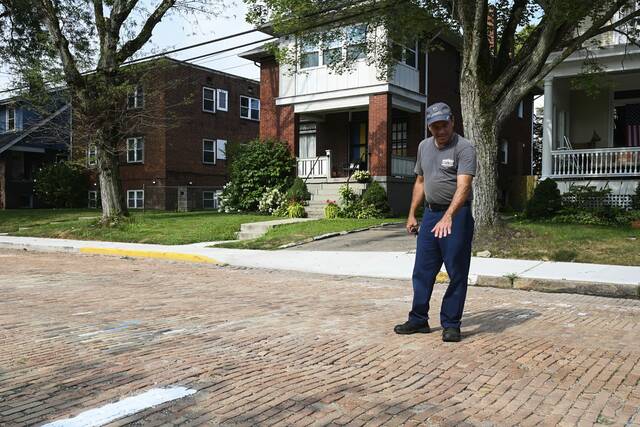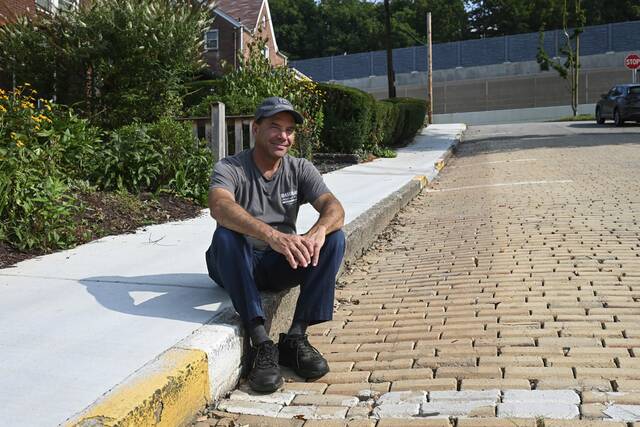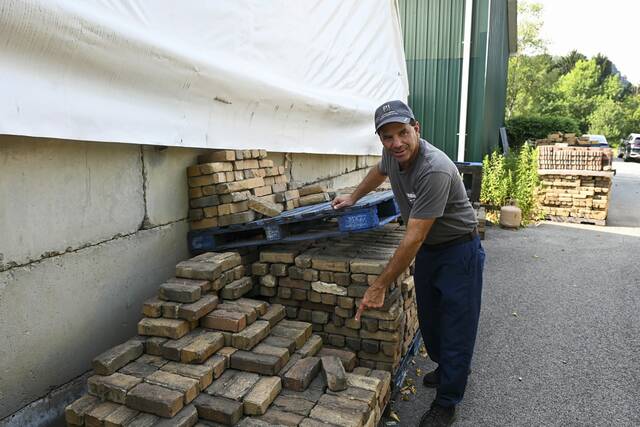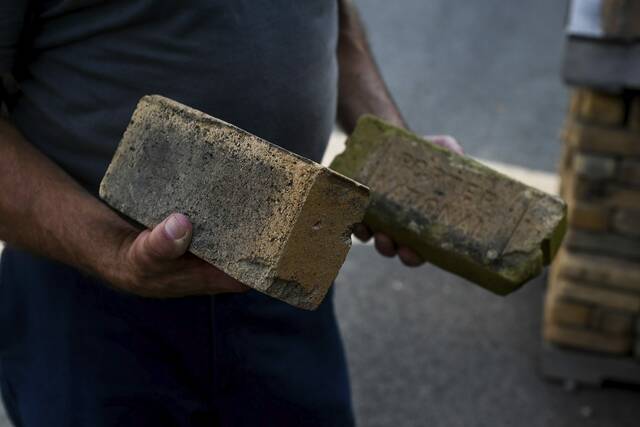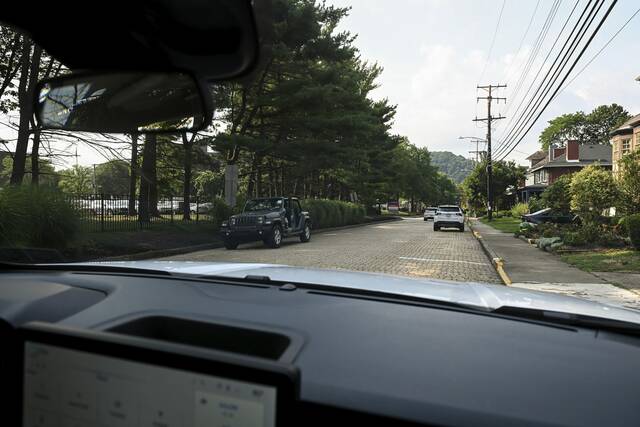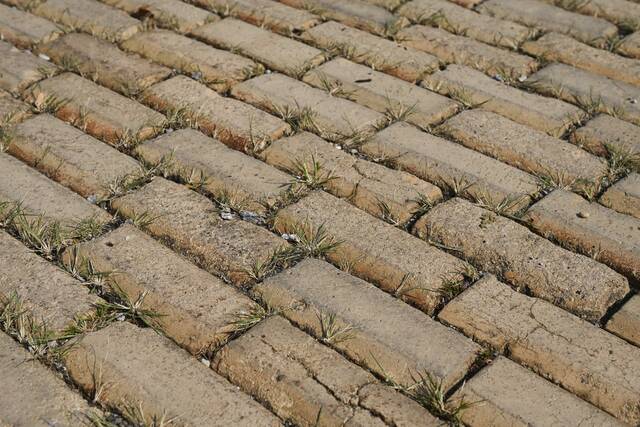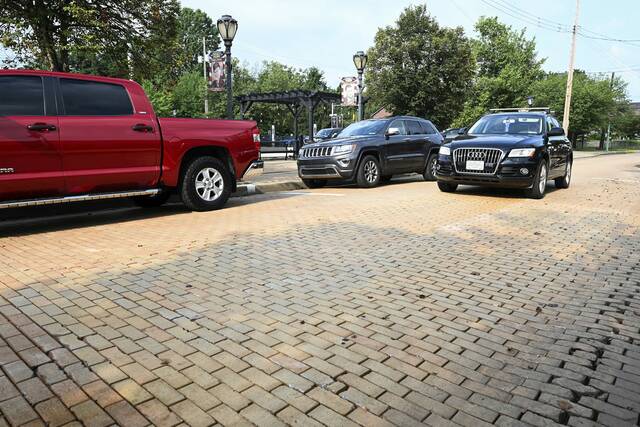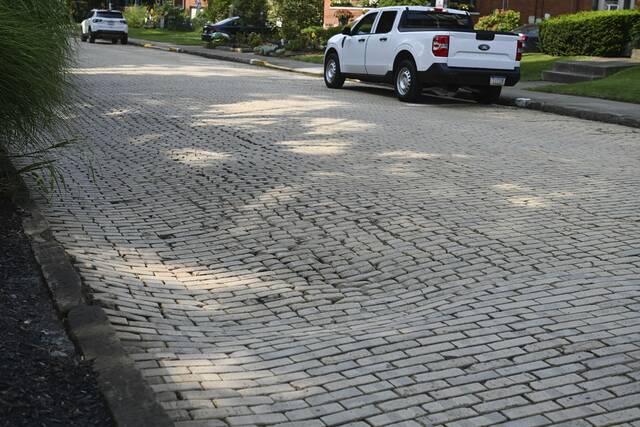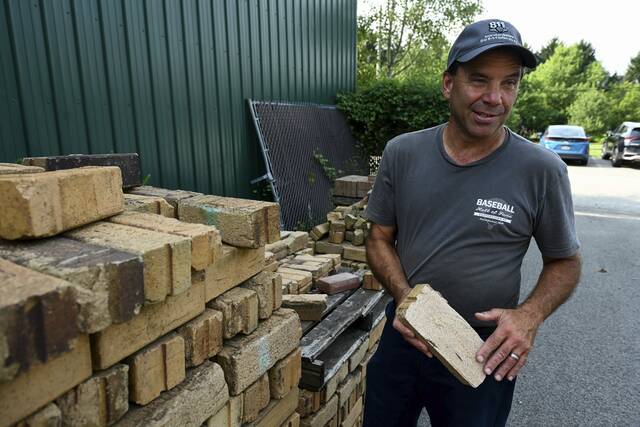Preserving historic brick streets ongoing endeavor for Aspinwall borough employees
The historic borough of Aspinwall has what most Pittsburgh-area towns do not: original brick streets and alleys dating back to the late 1800s.
They’re just one of the many charming elements of Aspinwall, founded in 1892, but keeping brick roads originally designed for horse and buggy wagons updated to accommodate modern-day vehicle traffic is an ongoing issue for the four-man Aspinwall Public Works crew.
Aspinwall Department of Public Works foreman Gene Marsico, 61, grew up in the borough and took a TribLive reporter and photojournalist on a brick-street tour July 29 to check out the most problematic brick streets requiring repair work.
Along the 200 block of Delafield Road, Marsico pointed out a large swath of brick slated for repair work.
Heavy vehicle traffic is a daily reality along Delafield and portions of the road are riddled with uneven, low, cracked, missing and crooked bricks.
The dips sometimes make for treacherous driving and vehicles with low clearance often bottom out and scrape against the bricks, particularly when drivers speed.
“Some of these cars go by here really fast and then they learn,” Marsico said. “The weight of the vehicles — the school buses, garbage trucks and tractor trailers — it just crushes them.”
When Victorian-influenced Aspinwall was first settled, residents navigated the dirt streets on wooden boardwalks that served as sidewalks.
When the streets were later upgraded with almost four miles of brick streets, the never-ending cycle of brick maintenance began.
The oldest bricks in Aspinwall came from the Paul Morrow Brick Company in Kittanning, Armstrong County, according to Aspinwall historian and longtime resident Terry Nelson Taylor, author of “Aspinwall, The Town That Pride Built.”
Bricks made by the Paul Morrow Brick Company were known for their quality, durability, larger size and for their unique, cream color.
Taylor said many of the bricks on Delafield Road bear the Kittanning embossed relief name.
“The borough had a high bar and I believe the Aspinwall founding fathers had the right idea and they wanted a durable infrastructure. You don’t find bricks creating potholes,” Taylor said.
Although many streets have since been paved over, like in Brilliant Avenue’s business district, numerous brick roads, including Lexington, Maple, Commercial, Center and Emerson avenues and First, Third, Fourth, Fifth, Sixth and Tenth streets remain.
The most recent brick repairs were completed this month along Emerson Avenue during a several-day project.
About 40 percent of bricks removed during a repair patch project are junk, Marsico said.
“They have to be totally replaced and we have bricks down at our borough garage,” Marsico said.
Consistently repairing damaged bricks comes at a price.
In 2025, the borough paid $12 a square foot for patch repairs and a total of 3,600 square feet of brick was patched on various streets, at a total cost of $43,200.
The 2025 brick repair budget is $148,000.
Public asset
Aspinwall councilwoman Lara Voytko recalled house hunting and noticing the uniqueness of brick-lined streets in Aspinwall.
“I felt like I was entering a Norman Rockwell painting and knew I wanted to live in Aspinwall,” said Voytko, Aspinwall Council chair of infrastructure. “My fondness for our brick streets is not only sentimental, but also practical.”
Voytko cited that brick streets may have higher upfront costs for installation and have expensive individual repairs, but cost less in the long run due to their durability.
Brick streets have sustainability elements and tend to be durable, with a life expectancy of up to 100 years and can be repaired without fully reconstructing the street.
Light-colored bricks, which are prevalent in Aspinwall, reflect sunlight and help minimize the urban heat effect.
Additionally, the brick streets slow down both traffic and stormwater runoff.
Borough council hosted several public seminars to survey residents on their opinions and suggestions regarding infrastructure.
“Preserving and maintaining the brick streets was a forefront issue,” Voytko said. “There may be occasions where it’s not fiscally responsible to preserve the brick streets when addressing underlying infrastructure problems such as water and sewer lines, but with deliberate and careful planning, we hope to largely avoid having to pave a currently bricked avenue.”
Voytko has served on council for eight years and is currently working with Mayor Joe Noro, borough manager Melissa Lang O’Malley and Marsico to develop a long-term plan of scheduled maintenance and repairing the brick in the same manner the borough successfully approaches the paved streets.
Noro described the brick streets as picturesque.
“It adds to our community charm in our town along with our beautiful, historical houses,” he said. “When I talk with the community, the one thing people mention to me is to keep the brick roads.”
Aspinwall’s brick streets are considered integral to the borough’s aesthetic, noted Aspinwall Borough manager Melissa Lang O’Malley.
“Aspinwall has a policy of reconstructing brick streets with brick when possible, demonstrating a commitment to maintaining its historical charm,” O’Malley said.
Bricks at-the-ready
Thousands of stacks of bricks are stored at the borough garage and are used on brick patch projects.
They’re cleaned and stacked and stacked on pallets to provide a surplus of bricks that can be used for repairs.
“We haven’t found any treasure,” joked Marsico of what’s underneath the brick streets (dirt).
Many of the bricks are the engraved Porter National brand of paver brick.
Many of the original bricks in different sizes and hues are selected and used wherever needed on various brick patch projects.
“Aspinwall is known for its charming brick streets, particularly in the Sauer Buildings Historic District. These brick roads are often lined with Colonial Revival and Foursquare homes. The town’s commitment to preserving its historical character is reflected in its policy of reconstructing brick streets with brick when feasible,” O’Malley said.
The Sauer Buildings Historic District occupies homes between 607 and 717 Center Ave., all designed and built by German-American architect Frederick C. Sauer.
O’Malley referenced the following brick streets that have been repaired in the last five years: portions of Fourth, Fifth and Third Streets.
“That is work done in specific areas of the road that are lumpy, bumpy and in disrepair,” O’Malley said.
Lexington Avenue is scheduled to be patched by the end of this year, along with Delafield, which ironically was actually once paved over, then the pavement was removed and the bricks restored during the 1960s, according to former retired Aspinwall Public Works Supervisor Lee Albacker.
A start date or timeline for brick repair along Delafield hasn’t been decided.
“We still need to get estimates and finalize the budget for the project,” O’Malley said.
Aspinwall Council makes decisions on the roads that are paved or rebricked.
A section of Emerson and a 90-foot section of Fourth Street were most recently completed, and the low, dipped bricks are now even.
Marsico said those repairs should last about a decade.
“We have to deal with the bricks all of the time and Delafield Road is its own animal because the drivers are speeding and not paying attention,” Marsico said.
Albacker spent 37 years working with his public works crew to stay ahead of brick repair and lives on a brick street himself.
He pointed out that during wintertime, borough plows are outfitted with special rubber blades in place of the usual steel blades so the bricks aren’t plowed up too.
Acquiring bricks is another costly problem, so the borough has a large stored supply of used bricks at the ready.
When Oakmont Borough replaced its bricks along Allegheny River Boulevard during the 1980s, Albacker bought “truckloads” of the yellow bricks unwanted by Oakmont and then Aspinwall reused them for brick repairs.
Albacker offered a price comparison of brick versus paving costs from the 1980s, recalling a price estimate to brick one block of Fourth Street ($180,000) compared to paving that same section for $30,000.
“The major problem is that there’s no road bed and when it gets soggy during the freeze and thaw, the brick can heave up,” Albacker said.
Upon close examination of the brick on the upper portions of Emerson and Delafield, the bricks are beveled, a brick laying style with a practical aspect.
“They did that for the horses so when they were going up and down the hill their horseshoes could get traction,” Albacker said.
Keeping the brick streets and alleyways structurally sound is something Albacker noted is the direct result of the hard work of public works department employees Gene Marsico, Ryan Costello, J.C. Teyssier and Jake Poznick.
“Aspinwall is a nice town and people say the police keep the town nice, but the public works keeps it clean, fresh and has worked hard to keep the town nice,” Albacker said.
Joyce Hanz is a native of Charleston, S.C. and is a features reporter covering the Pittsburgh region. She majored in media arts and graduated from the University of South Carolina. She can be reached at jhanz@triblive.com
Remove the ads from your TribLIVE reading experience but still support the journalists who create the content with TribLIVE Ad-Free.

